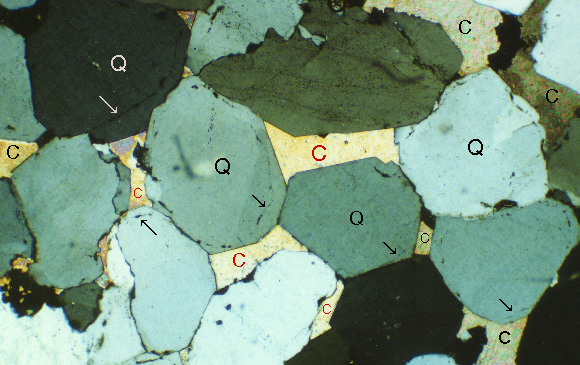Photomicrograph was taken in cross-polarized light; field of view is 2.3 mm wide. Mesozoic, South America; Sample 9-2-7 Cb -1 - BA; thin section S-3-142. Sample donated by Dr. Gilles O. Allard.

| Figure A-9. Calcite cemented sandstone (specifically, a quartz arenite). Well-rounded quartz grains (Q) have euhedral quartz overgrowths beyond their original grain edges (arrows). Calcite (C) has filled remaining pore space. Four areas with red "C"s are all one crystal (a poikilotopic crystal) that has grown through pore throats into multiple pores. Note that quartz cementation took place without the nucleation of any new crystals: all the quartz cement is overgrown on the pre-existing lattices of the quartz grains. Four areas labelled with red "C"s were filled as the result of one calcite nucleation. This tendency to precipitate minerals with minimal nucleation of new crystals is typical of groundwaters that are not highly supersaturated with respect to the precipitating phase. In precipitation of speleothems, degassing of CO2 and/or evaporation can, but does not always, cause high supersaturation. Photomicrograph was taken in cross-polarized light; field of view is 2.3 mm wide. Mesozoic, South America; Sample 9-2-7 Cb -1 - BA; thin section S-3-142. Sample donated by Dr. Gilles O. Allard. |
|
 |
|
| Back to the Table of Contents of the Atlas of Speleothem Microfabrics. |